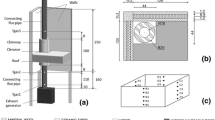Abstract
Recently, numerous fires have started in Finland around roof penetrations of metal chimneys. One reason for the fires is the high flue gas temperatures of fireplaces. EN standards do not determine the flue gas temperatures of fireplaces meant for the specification of temperature classes of chimneys. At present, the design of chimneys is based on the temperature indicated in the CE marking of fireplaces. The temperature indicated in the CE marking is the mean temperature of the nominal test. In order to investigate how representative and safe this mean temperature is, tests on different fireplaces were conducted. Flue gas temperatures of the fireplaces were measured during a nominal test, a safety test and extra heating. Even in the nominal test, the highest flue gas temperature was 37°C to 212°C higher than the mean temperature. The highest flue gas temperature in the safety tests was about 120°C to 380°C higher than the mean temperature indicated in the CE marking. During the extra heating test, the highest flue gas temperature was 160°C to 350°C higher than that indicated in the CE marking. Due to the present method of determining flue gas temperatures, chimneys may be tested at a too low temperature.










Similar content being viewed by others
References
Official Statistics of Finland: buildings and free-time residences (web publication) appendix table 2. buildings by occupancy in 1980–2012. helsinki: statistics finland (cited: 4 oct 2013). http://www.stat.fi/til/rakke/2012/rakke_2012_2013-05-24_tau_002_fi.html (in finnish)
official statistics of Finland: buildings and free-time residences (Web publication). http://www.stat.fi/til/rakke/index.html (in Finnish)
Torvelainen J (2009) Use of firewood in detached houses 2007/2008. Vantaa 2009, Finnish Forest Research Institute Metla, Vantaa Unit, Forest Statistics Information Service. Metla bulletin 26/2009, p 3 (in Finnish)
Leppänen P (2010) Fire safety of metal chimneys. Master’s Thesis. Tampere 2010. Tampere University of Technology, Department of Civil Engineering, p 51 (in Finnish)
Hakala V-M (2013) Fire investigations, thematic investigation 3, 2012: chimney and fireplace as causes of fire, p 14 (in Finnish)
Murtokare M Roof safety survey report 2012, The Central Association of Chimney Sweeps, p 40 (in Finnish)
Inha T, Leppänen P, Peltomäki M, Pentti M Fire safety of light-weight metal chimneys. Tampere 2011, Tampere University of Technology, Department of Civil Engineering. Research report no. PALO 1950/2011. 52 p +25 . app (in Finnish)
Koistinen R, Saastamoinen J, Aho M Mechanism of combustion of solid fuel particle. A review. Espoo 1986, Technical Research Centre of Finland, Research Notes 555, p 89 (in Finnish)
Vuorelainen O Wood as a fuel and wood-fired appliances. Helsinki 1958, The State Institute for Technical Research, Report—Series III—Building 25, p 115 (in Finnish)
Peacock RD (1987) Wood heating safety research: an update. Fire Technol 23(4):292–312
Peacock RD Thermal performance of masonry chimneys and fireplaces. Gaithersburg 1987, U.S. Department of Commerce National Bureau of Standards National Engineering Laboratory Center for Fire Research, NBSIR 87-35315, p 175
Hansen FH, Hjelmeland T, Landrø H, Østnor A final report: cracking in flue liner of multi-wall chimney—investigation conserning future fire risk and function. Trondheim 1997, Sintef Energy. Norwegian Fire Research Laboratory, STF84 A97626, p 45 (in Norwegian)
SFS-EN 1443:2003 Chimneys General requirements. Brussels: European Committee for Standardization (CEN), p 39
SFS-EN 13240:2001/A2:2004/AC:2007 Room heaters fired by solid fuel. Requirements and test methods. Brussels: European Committee for Standardization (CEN), p 70
SFS-EN 13229:2001/AC:2006 Inset appliance including open fires fired by solid fuels. Requirements and test methods. Brussels: European Committee for Standardization (CEN), p 75
SFS-EN 15250:2007 Slow heat release appliances fired by solid fuel. Requirements and test methods. Brussels: European Committee for Standardization (CEN), p 63
SFS-EN 15821:2010 Multi-firing sauna stoves fired by natural wood logs. Requirements and test methods. Brussels: European Committee for Standardization (CEN), p 55
SFS-EN 1856-1:2009 Chimneys Requirements for metal chimneys. Part 1: System chimney products. Brussels: European Committee for Standardization (CEN), p 55
Kaukanen K Expert report on need of higher temperature classes of chimneys. Espoo 2013, VTT Expert Service Ltd, p 41 (in Finnish)
SFS-EN 1859:2009 Chimneys Metal chimneys. Test methods. Brussels: European Committee for Standardization (CEN), p 46
Inha T, Leppänen P, Peltomäki M, Pentti M Flue gas temperature of fireplaces. Tampere 2012, Tampere University of Technology, Department of Civil Engineering. Research report no. PALO 2133/2012. 22 p. +app, p 20
Oravainen H Flue gas temperature measurements of a slow heat release appliance, a sauna stove and a roomheater, Jyväskylä 2011, VTT Expert Service Ltd. Research report No. VTT-S-08754-11. 5 p. +app, p 5 (Courtesy of client)
Oravainen H Coefficient between average flue gas temperature in a normal test and maximum temperature in a safety test with slow heat release appliances. Jyväskylä 2012, VTT Expert Service Ltd, p 3 (Courtesy of client) (in Finnish)
Babrauskas V, Gray BF, Janssens ML (2007) Prudent practices for the design and installation of heat-producing devices near wood materials. Fire Mater 31:125–135
Matson AF, Dufour RE, Breen JF (1959) Survey of available information on ignition of wood exposed to moderately elevated temperatures, part II of “Performance of type B gas vents for gas-fired appliances” (Bull. of Research 51), Underwriters’ Laboratories, Inc., Chicago
Funding
The Fire Protection Fund of Finland has provided funding for my work.
Author information
Authors and Affiliations
Corresponding author
Rights and permissions
About this article
Cite this article
Leppänen, P., Inha, T. & Pentti, M. An Experimental Study on the Effect of Design Flue Gas Temperature on the Fire Safety of Chimneys. Fire Technol 51, 847–866 (2015). https://doi.org/10.1007/s10694-014-0415-4
Received:
Accepted:
Published:
Issue Date:
DOI: https://doi.org/10.1007/s10694-014-0415-4




